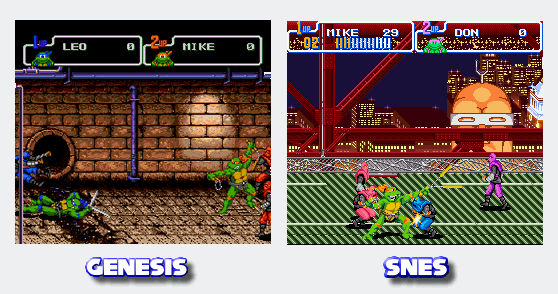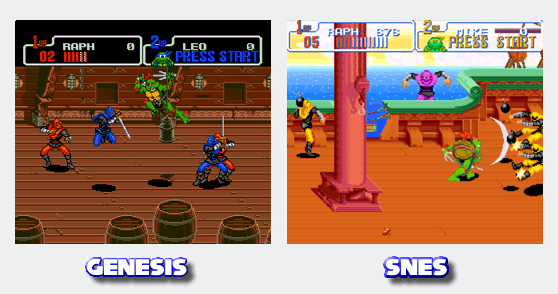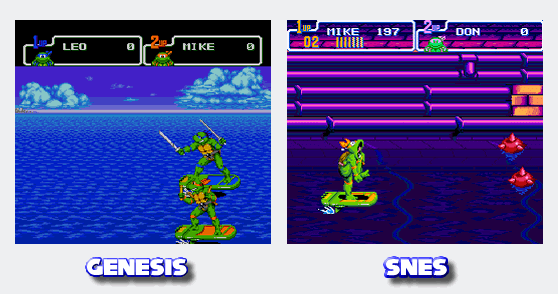It’s 1992, and Konami is rocking the arcades with TMNT IV: Turtles in Time. It becomes the best selling arcade game of the time. So of course, they decide to port it over to SNES and Genesis. But what’s this? The Genesis can’t seem to exactly handle the entirety of Turtles in Time, so instead we got a somewhat different game, The Hyperstone Heist. But is Genesis game really as half-assed a port as most people say it is, or should it get some real recognition alongside Turtles in Time? Let’s take a deeper look into both games.
The Differences
Presentation: Obviously, Turtles in Time has more levels than the Hyperstone Heist does, although they’re broken up differently on the Genesis when compared to the SNES. Where Turtles in Time has a boss (or two) per area, The Hyperstone Heist has one boss per scene and a scene contains multiple environments. For example, the first level of HH contains the second level of TiT, along with two sewer areas to make up one level. Turtles in Time keeps you in the same place, but Hyperstone Heist frequently changes environments, creating longer levels. There are five scenes on the Genesis, and ten levels on the SNES. This leads to Turtles in Time having twelve bosses, while its sibling has only five (and then a rehash of four of them in one of the levels). Now, The Hyperstone Heist only has five levels, but they’re much different than the ones in its SNES counterpart. For example, the turtles start in the sewer rather than on a bridge, the surfing level is out to sea (and not considered a bonus stage), and some levels are entirely new, like the Dojo and the Ghost Ship. The only stages that are ripped from Turtles in Time are three screens from Alleycat blues (the rest of the stage in Hyperstone Heist is different), and the final boss fight.
Also, only three bosses are have made the crossover to the Genesis: Leatherhead, Krang, and Shredder. But the Rocksteady and Baxter bosses that Hyperstone Heist uses are recycled from the first TMNT arcade game, leading to a stale experience at times if you’ve played through that coin-op. THH also includes a stage filled with nothing but past bosses. Still, Turtles in Time has a bit more variety than the Genesis game and is a longer game overall. Regardless, if you grew up playing one game rather than the other, when playing either game you’ll get that feeling of “haven’t I done this before?” when playing the other game. THH just has more of that feeling because most of the game is recycled from other TMNT games unfortunately.
Edge: Turtles in Time
Graphics: The graphics in each game are pretty much the same,
with each having slight variations in animation and colors. Colors are more vibrant in the Genesis version, and there’s more detail, while Turtles in Time is more colorful. Both games share a lot of the same sprites, but Turtles in Time has a few more animations, like the foot soldiers being thrown at the screen, and the turtles being slammed to the wall
after being hit. The Genesis version does unfortunately take a hit with the loss of the gimmicky foot soldier throw, and I’m going to have to give the edge to the SNES.
Edge: Turtles in Time
Sound/Music: The sound in the game is shared as well. Music is shared between the two games (although each one has an exclusive track or two), and both have fantastic soundtracks.
Personally, I prefer the Hyperstone Heist soundtrack though, and overall it sounds better.
In comparison to the arcade version, The Hyperstone Heist sounds a bit more faithful compared to Turtles in Time.
There is also some distinction between the voice work for both titles. The voices in on the Genesis are also better, but Turtles in Time makes more use of voice overall. The voices on THH are scratchy but sound more like the turtles from the show, whereas the SNES voices are clearer but sound dull and are hard to understand at times.
Select Your Turtle: Sega Genesis (MP3 1.17 megs) Select Your Turtle: SNES (MP3 760KB)
Gameplay: None of these other points are as important as the gameplay. At first glace both titles play identically, but as you go along you’ll realize that there are a couple of differences between the two. One major difference is the run feature. In Turtles in Time, you automatically run after walking for a few seconds, or you can set it to two taps of the D-pad to run. The Hyperstone Heist, however, assigns run to a button, making run combos much easier to pull off. I’d like to know why Konami didn’t assign run to a button in Turtles in Time. Between the slow-scrolling screen and the basic gameplay formula, holding down a direction to run in just isn’t practical at all when most of the time you’re standing still fighting enemies. As a result, the Hyperstone Heist becomes a much faster paced game than Turtles in Time. With the inclusion of the run button, running attacks are much easier to pull off, and makes this a lot more convenient.
On the other hand, the Hyperstone Heist is missing that gimmicky, but satisfying move where you throw the Foot soldier at the screen, the ability to press a direction and throw a foot soldier, and a battle much mode akin to the one in Streets of Rage 2, where the turtles duke it out against each other in their sewer home. These are all small losses though, especially the battle mode. It’s not really all that fun to play a bare-bones simplistic 2D fighter when I could be playing Street Fighter II instead. But the main gameplay difference between the two games is the hit detection. Turtles in Time’s hit detection just isn’t as good as THH’s. Overall, it’s not too bad, but you lose some of the range the turtles have because of it. THH’s hit detection is a lot better in comparison, and is pretty much perfect. Between that and the better run system give it the edge.
Edge: Hyperstone Heist
Other: Both games have different storylines. On the SNES, Shredder has stolen the Statue of Liberty and midway through the game Shredder decides that he’s had enough of the turtles, and has them whisked away to different time periods. In Hyperstone Heist, Shredder has obtained something called the Hyperstone that gives him the power to shrink all of New York City to action-figure size and give him super powers, and the turtles give chase. To be honest, the story of Hyperstone Heist makes a bit more sense than Turtles in Time. It’s pretty cut-and-dry “Get Shredder,” whereas the other game’s story doesn’t really tell you why he’s stolen the Statue of Liberty
(maybe he lost the miniature to his New York City playset as seen in the intro?), or how the turtles get to each time period. Personally, I think the turtles feel out of place in the wild, wild west and prehistoric times, since there’s really no threat to them there.
Replay value is another area where the two games are different.
Since both are really good beat-’em-ups, they can be played over and over again without getting stale. But since Turtles in Time is longer and is a much harder game, chances are you’ll be getting more playtime out of it than Hyperstone Heist.
Edge: Draw
Final Assessment
In short, what Hyperstone Heist lacks in levels and variety, it makes up in basic gameplay and sound. The Genesis turtles game may seem like a half-assed port of Turtles in Time at first, but you’ll soon realize that it plays better and it has enough differences to be a very enjoyable experience. Overall, each game has their weaknesses and their strengths, but don’t sell Hyperstone Heist short due to a lack of flashy features and effects as seen in Turtles in Time.




Recent Comments